At a cost of €300/ac, reseeding is an expensive exercise but one that can bring many benefits. If done correctly, it has the potential to increase productivity through increased grass-quality, utilisation and a better response to fertiliser. But in order to get these benefits, the following 10 steps should be applied in your reseeding plan this year.
When?
Deciding when to reseed can often be the first stumbling block. Both spring and autumn reseeding have their positives and negatives but, for both, it takes the sward around 11 months to become fully established. Spring reseeding is more favourable as it is easier managed due to weather and ground conditions being more suitable for seed germination, post-emergence spraying and the early management of the sward.
The downside to spring reseeding is when it is not done early enough the dry weather can slow down germination and therefore delay turnaround.
Targeting a turnaround time of 60 days can often lead to a spring reseed yielding the same if not more grass than an old permanent pasture.
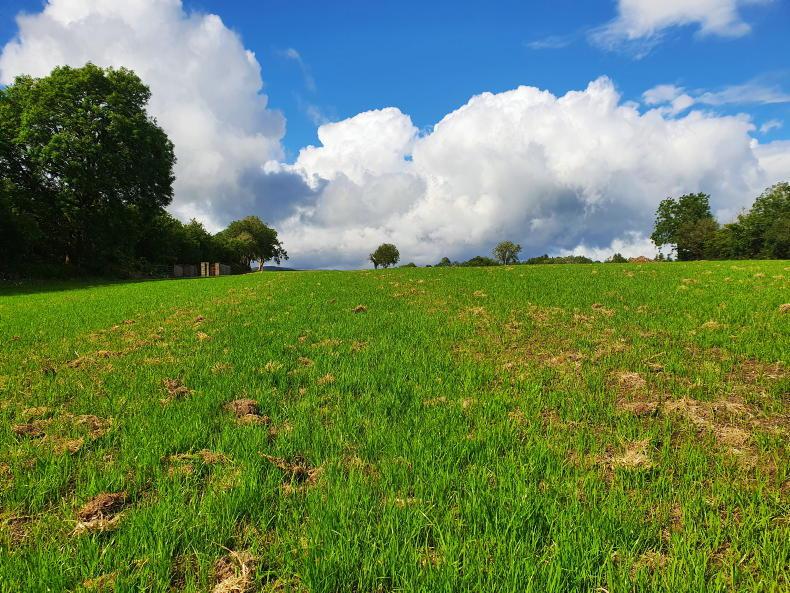
The preparation of a fine firm and level seed bed is essential.
Autumn reseeding when done in late July or early August can be very successful.
However, if done later a notable downside is the deterioration in the weather conditions and lower soil temperatures which can reduce germination, make it difficult to graze and disrupt post emergent spraying.
Where?
When deciding where to reseed you should identify the under-performing paddocks on the farm. Assessing the openness of the sward, ryegrass content and other grasses and weeds present in the paddock can form part of the decision. For those grass measuring, the annual tonnage graph on PastureBase Ireland will easily identify your worst-performing paddocks.
Soil test
Soil fertility is critical to the success of a reseed. Carrying out soil tests before reseeding will give a true picture of the phosphorus (P), potassium (K) and lime requirements of the soil. You are targeting Index 3 for P and K. The target soil pH is 6.3 for mineral soils and 5.5 for peat soils. Soils with very low indices for P and K should be targeted for buildup before reseeding takes place.
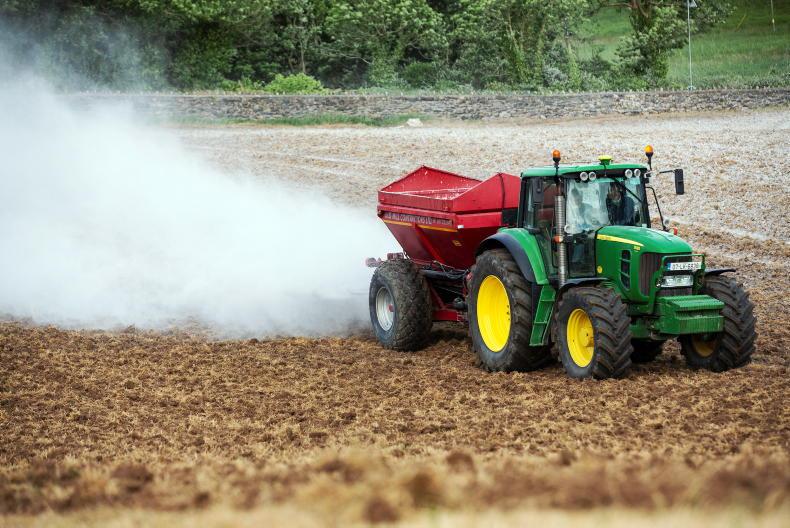
Lime applied to achieve a target pH of 6.3 (5.5pH on peaty soils).
Apply lime as required by soil samples, the maximum in a single application is 7.5t/ha (3t/ac). When using minimum tillage techniques, the old decaying sward can lead to acidity in the soil. Lime applications will help to counteract this. Where ploughing is taking place, a soil test should be done again the following year to ensure the soil brought to the surface is fertile.
Spraying off
Weather conditions must be suitable for spraying off the old permanent pasture. If there are perennial weeds such as docks and ragwort present, use a glyphosate spray. Cultivation can begin seven to 10 days after spraying. Delaying longer than 10 days results in a delayed turn around but may be important where there is heavy dock infestation. Time is needed for the chemical to translocate from the leaf to the root and ensure a good kill.
Cultivation
Preparing the seed bed begins with removing the trash by grazing the sward tightly or mowing after spraying off. The target is to develop a fine, firm and level seedbed whichever your preferred method of cultivation. There are four main methods of cultivation:
Ploughing
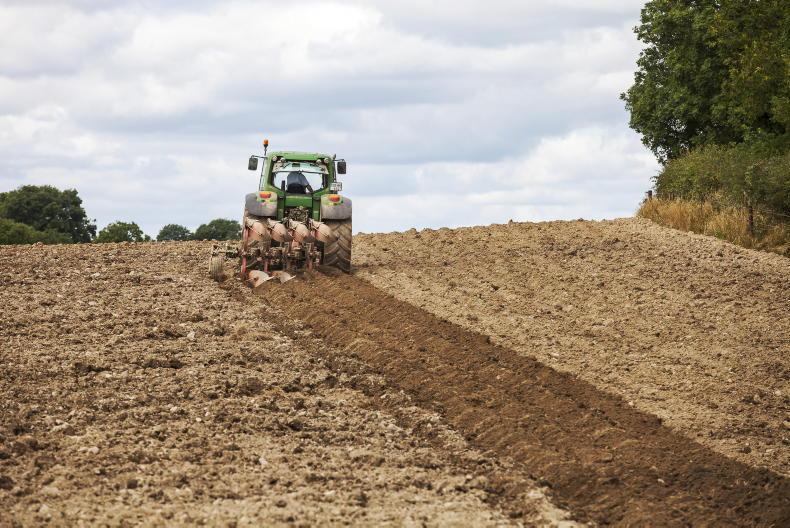
Ploughing to a maximum of 15cm to avoid burying the most fertile layer of soil.
Avoid ploughing more than 15cm as this will bury the most fertile layer of soil.Land levelling is essential to create an even seed bed. Step-by-step: plough/lime/land level/spread fertiliser/one pass with seed/roll.Discing and one pass
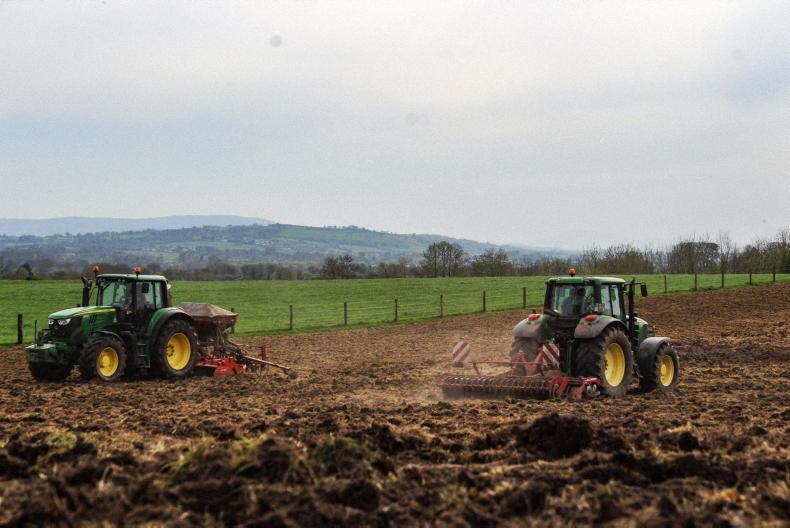
Discing and one pass.
Two or three passes in different directions are required to break up the sod.Tight grazing/mowing is important to minimise trash.Step-by-step: disc/land level/spread lime/spread fertiliser/one pass with seed/ roll.One pass
To break up the sod this must be done slowly. If not, results can be varied and achieving a fine firm seed bed is very difficult.Step by step: lime/one pass (no seed)/fertiliser/one pass (with seed)/roll.Direct drill
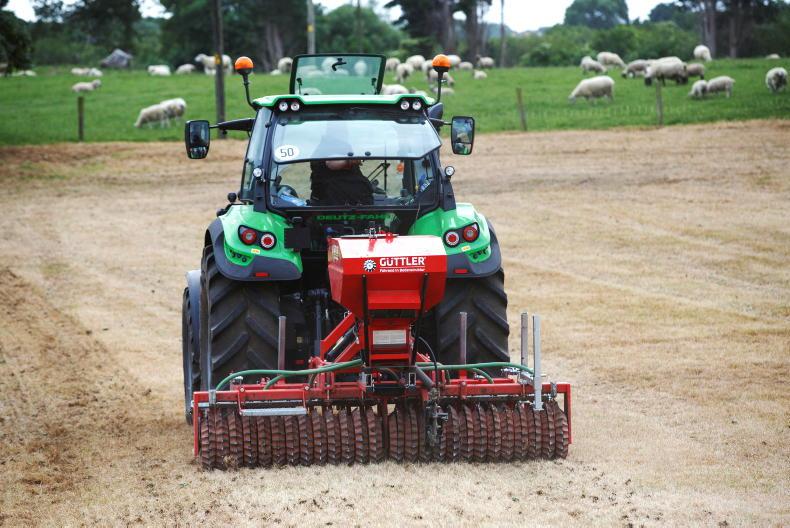
Direct drilling: minimum disruption of the soil.
With less seed bed preparation plant emergence can be slower but will come. The old sward must be grazed tight or have been mowed and trash removed.Slug pellets essential.Step by step: lime/spread fertiliser/direct drill.Picking a variety
The first thing to consider when choosing a variety is the end goal. Will it be grazed or will it be cut for silage two or three times a year. The pasture profit index (PPI) is an index-based ranking of varieties which puts a monetary value on a range of production traits. It is highly recommended that all varieties in a mix are present on the PPI. The PPI is grouped by heading dates and ploidy: tetraploid – more open sward, diploid – denser sward. The heading date is when the plant enters the reproductive stage (produces a seed head). The heading dates of all varieties in a mix must be within seven days of each other and there should be no more than three or four varieties in one mix. Farms in derogation are now required to include a clover seed when reseeding.
Fertiliser application
Fertiliser application should be dictated by the soil sample results. In the early stages of plant development, there is a large requirement for P and K. For this reason, it is very important to spread a compound fertiliser when sowing the seed.
The most common fertiliser used when reseeding is 10:10:20 at a rate of three bags/acre. Nitrogen becomes more important in the post-emergence period and should be spread at a rate of 30 units/acre when sowing, followed by 30 units/acre on week five or six.
Rolling
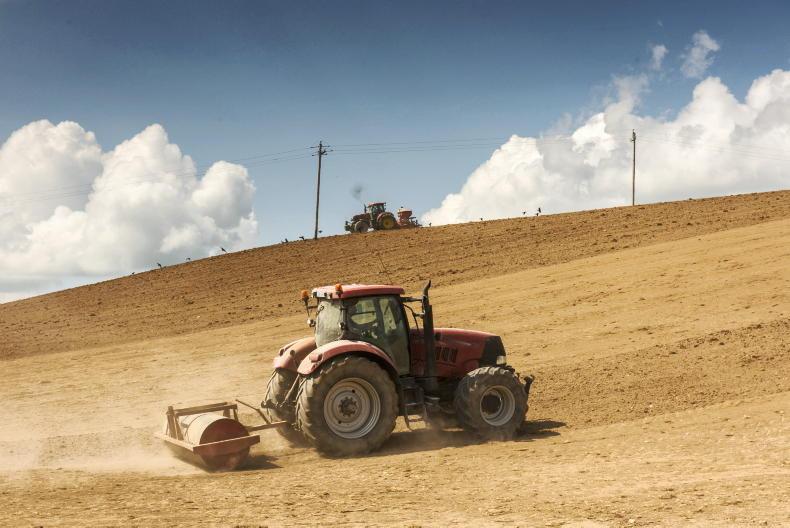
Rolling to ensure good seed-to-soil contact to promote germination.
What is possibly the easiest part of the process is often the one that is forgotten about. Rolling immediately after sowing will optimise seed to soil contact helping to promote germination.
Post-emergence spray
Post-emergence spraying is the one opportunity you have to kill weeds at the seedling stage (dock leaf the size of a €2 coin). Spray six to eight weeks after sowing with a herbicide when the grass has three leaves and there is one true leaf on the clover. Choosing a herbicide that will target the weeds specific to your reseed is vital. There is no clover-safe product on the market at the minute. See page 48.
Managing the reseed
A simple way to check if the reseed is ready for grazing is by pulling the grass and if the roots don’t pull out, it’s good to go. Target a first grazing at a low cover of 700kg to 1,000kgDM/ha as this will encourage tillering, which will result in a more dense sward. For subsequent grazings, target pre-grazing covers of 1,200kg DM to 1,400kg DM/ha. Grazing with lighter stock is advisable but if conditions are good grazing with older stock will mean grazing the paddock faster.
Target poorer-performing paddocks for reseeding.Spray off and leave for seven to 10 days before cultivating.Use the PPI when selecting varieties.Target P and K application at sowing.Follow up with nitrogen five to six weeks later. Rolling is essential for seed to soil contact.Post-emergence spray when grass is at the three-leaf stage and weeds are the size of a €2 coin.Graze at a cover of 700kg DM/ha to 1,000kg DM/ha.
At a cost of €300/ac, reseeding is an expensive exercise but one that can bring many benefits. If done correctly, it has the potential to increase productivity through increased grass-quality, utilisation and a better response to fertiliser. But in order to get these benefits, the following 10 steps should be applied in your reseeding plan this year.
When?
Deciding when to reseed can often be the first stumbling block. Both spring and autumn reseeding have their positives and negatives but, for both, it takes the sward around 11 months to become fully established. Spring reseeding is more favourable as it is easier managed due to weather and ground conditions being more suitable for seed germination, post-emergence spraying and the early management of the sward.
The downside to spring reseeding is when it is not done early enough the dry weather can slow down germination and therefore delay turnaround.
Targeting a turnaround time of 60 days can often lead to a spring reseed yielding the same if not more grass than an old permanent pasture.

The preparation of a fine firm and level seed bed is essential.
Autumn reseeding when done in late July or early August can be very successful.
However, if done later a notable downside is the deterioration in the weather conditions and lower soil temperatures which can reduce germination, make it difficult to graze and disrupt post emergent spraying.
Where?
When deciding where to reseed you should identify the under-performing paddocks on the farm. Assessing the openness of the sward, ryegrass content and other grasses and weeds present in the paddock can form part of the decision. For those grass measuring, the annual tonnage graph on PastureBase Ireland will easily identify your worst-performing paddocks.
Soil test
Soil fertility is critical to the success of a reseed. Carrying out soil tests before reseeding will give a true picture of the phosphorus (P), potassium (K) and lime requirements of the soil. You are targeting Index 3 for P and K. The target soil pH is 6.3 for mineral soils and 5.5 for peat soils. Soils with very low indices for P and K should be targeted for buildup before reseeding takes place.

Lime applied to achieve a target pH of 6.3 (5.5pH on peaty soils).
Apply lime as required by soil samples, the maximum in a single application is 7.5t/ha (3t/ac). When using minimum tillage techniques, the old decaying sward can lead to acidity in the soil. Lime applications will help to counteract this. Where ploughing is taking place, a soil test should be done again the following year to ensure the soil brought to the surface is fertile.
Spraying off
Weather conditions must be suitable for spraying off the old permanent pasture. If there are perennial weeds such as docks and ragwort present, use a glyphosate spray. Cultivation can begin seven to 10 days after spraying. Delaying longer than 10 days results in a delayed turn around but may be important where there is heavy dock infestation. Time is needed for the chemical to translocate from the leaf to the root and ensure a good kill.
Cultivation
Preparing the seed bed begins with removing the trash by grazing the sward tightly or mowing after spraying off. The target is to develop a fine, firm and level seedbed whichever your preferred method of cultivation. There are four main methods of cultivation:
Ploughing

Ploughing to a maximum of 15cm to avoid burying the most fertile layer of soil.
Avoid ploughing more than 15cm as this will bury the most fertile layer of soil.Land levelling is essential to create an even seed bed. Step-by-step: plough/lime/land level/spread fertiliser/one pass with seed/roll.Discing and one pass

Discing and one pass.
Two or three passes in different directions are required to break up the sod.Tight grazing/mowing is important to minimise trash.Step-by-step: disc/land level/spread lime/spread fertiliser/one pass with seed/ roll.One pass
To break up the sod this must be done slowly. If not, results can be varied and achieving a fine firm seed bed is very difficult.Step by step: lime/one pass (no seed)/fertiliser/one pass (with seed)/roll.Direct drill

Direct drilling: minimum disruption of the soil.
With less seed bed preparation plant emergence can be slower but will come. The old sward must be grazed tight or have been mowed and trash removed.Slug pellets essential.Step by step: lime/spread fertiliser/direct drill.Picking a variety
The first thing to consider when choosing a variety is the end goal. Will it be grazed or will it be cut for silage two or three times a year. The pasture profit index (PPI) is an index-based ranking of varieties which puts a monetary value on a range of production traits. It is highly recommended that all varieties in a mix are present on the PPI. The PPI is grouped by heading dates and ploidy: tetraploid – more open sward, diploid – denser sward. The heading date is when the plant enters the reproductive stage (produces a seed head). The heading dates of all varieties in a mix must be within seven days of each other and there should be no more than three or four varieties in one mix. Farms in derogation are now required to include a clover seed when reseeding.
Fertiliser application
Fertiliser application should be dictated by the soil sample results. In the early stages of plant development, there is a large requirement for P and K. For this reason, it is very important to spread a compound fertiliser when sowing the seed.
The most common fertiliser used when reseeding is 10:10:20 at a rate of three bags/acre. Nitrogen becomes more important in the post-emergence period and should be spread at a rate of 30 units/acre when sowing, followed by 30 units/acre on week five or six.
Rolling

Rolling to ensure good seed-to-soil contact to promote germination.
What is possibly the easiest part of the process is often the one that is forgotten about. Rolling immediately after sowing will optimise seed to soil contact helping to promote germination.
Post-emergence spray
Post-emergence spraying is the one opportunity you have to kill weeds at the seedling stage (dock leaf the size of a €2 coin). Spray six to eight weeks after sowing with a herbicide when the grass has three leaves and there is one true leaf on the clover. Choosing a herbicide that will target the weeds specific to your reseed is vital. There is no clover-safe product on the market at the minute. See page 48.
Managing the reseed
A simple way to check if the reseed is ready for grazing is by pulling the grass and if the roots don’t pull out, it’s good to go. Target a first grazing at a low cover of 700kg to 1,000kgDM/ha as this will encourage tillering, which will result in a more dense sward. For subsequent grazings, target pre-grazing covers of 1,200kg DM to 1,400kg DM/ha. Grazing with lighter stock is advisable but if conditions are good grazing with older stock will mean grazing the paddock faster.
Target poorer-performing paddocks for reseeding.Spray off and leave for seven to 10 days before cultivating.Use the PPI when selecting varieties.Target P and K application at sowing.Follow up with nitrogen five to six weeks later. Rolling is essential for seed to soil contact.Post-emergence spray when grass is at the three-leaf stage and weeds are the size of a €2 coin.Graze at a cover of 700kg DM/ha to 1,000kg DM/ha. 










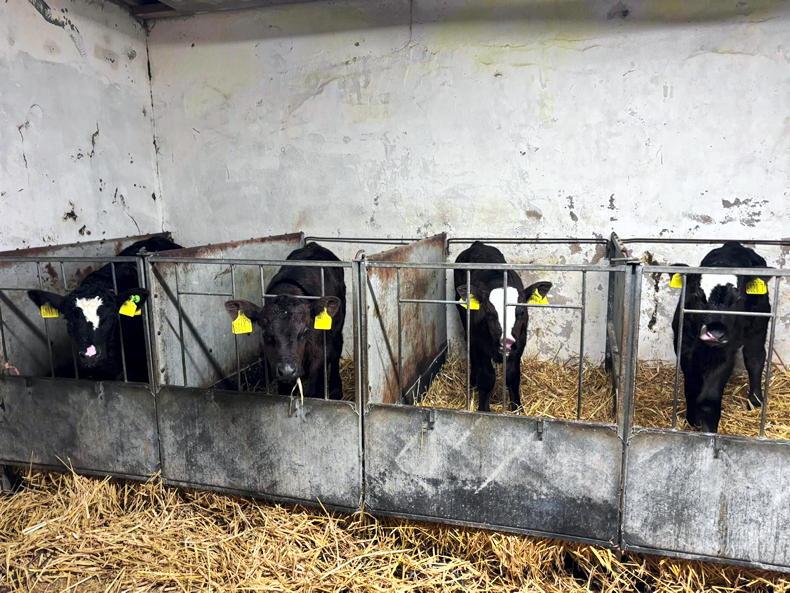

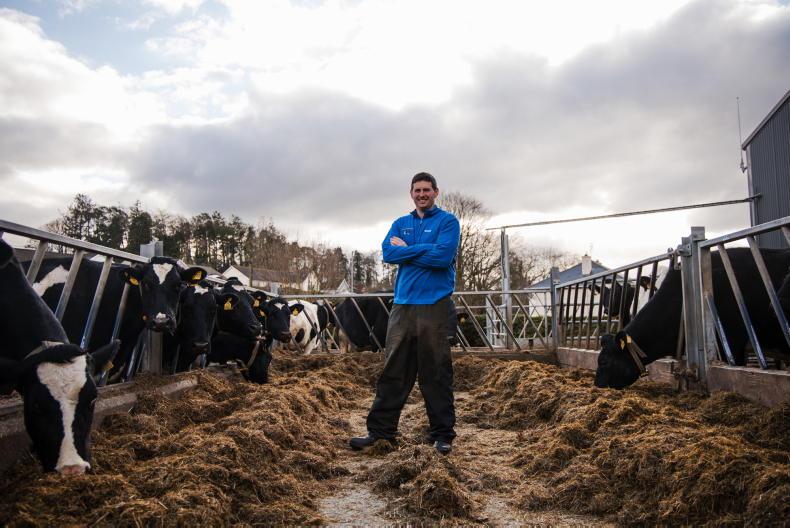
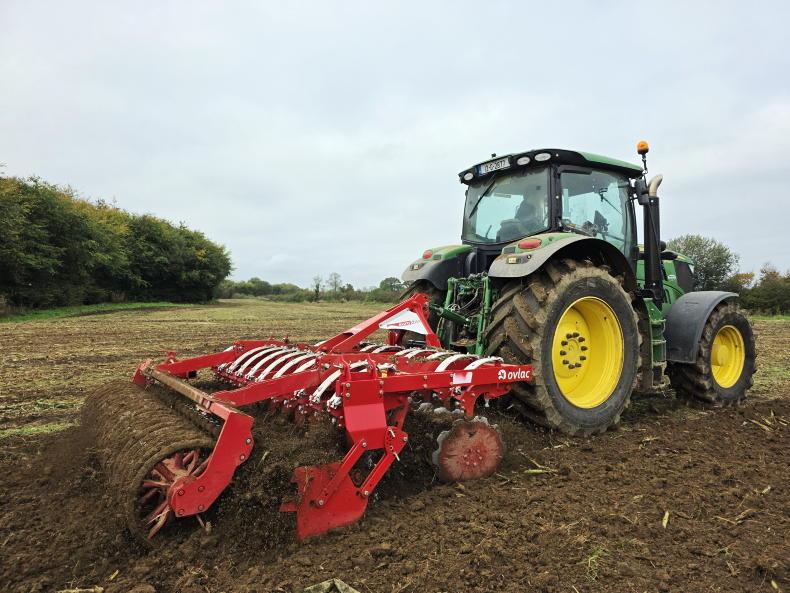

SHARING OPTIONS